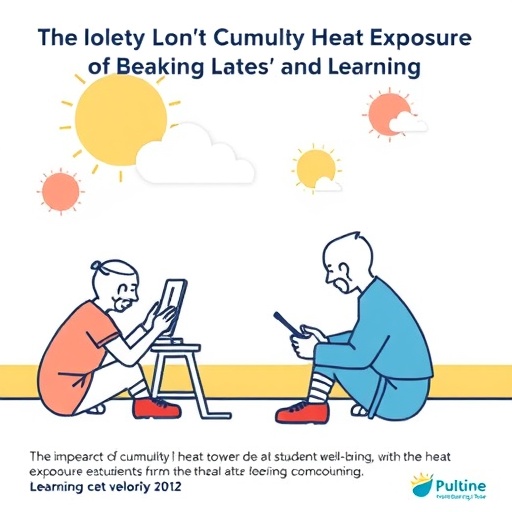A groundbreaking study published in the open-access journal PLOS Climate explores the alarming consequences of cumulative heat exposure on the cognitive performance of young students, highlighting an urgent public concern as temperatures continue to rise due to climate change. Researchers Konstantina Vasilakopoulou of the Royal Melbourne Institute of Technology and Matthaios Santamouris from the University of New South Wales conducted a systematic review that examined the socioeconomic and educational implications of prolonged heat exposure, emphasizing that these effects are felt most acutely by the most vulnerable populations.
As global temperatures soar, the impact of heat stress on human health and productivity has become a critical area of research. High temperatures have been shown to detrimentally affect cognitive functions such as memory, decision-making, and learning capabilities. The evidence presented in this article reinforces the idea that excessive heat not only compromises health but also undermines academic achievement and the overall intellectual development of students. The study presents a harrowing picture of how these heat-related impairments could derail the educational trajectories of young individuals, ultimately hindering their professional futures and social contributions.
Despite the extensive research on immediate and short-term heat exposure effects, there has been a significant gap in understanding long-term implications for students. With global and regional climates changing rapidly, it has become critical to address the cognitive ramifications of continuous exposure to high temperatures. To fill this void, Vasilakopoulou and Santamouris reviewed seven studies that together encompass nearly 14.5 million students across 61 countries, linking their cognitive learning outcomes directly to heat exposure. The findings are sobering; there is consistent evidence that long-term heat exposure significantly hampers students’ academic performance, particularly in complex subjects like mathematics, compared to simpler tasks such as reading.
The implications of these findings are vast. Six out of the seven studies considered in the review established a significant negative correlation between extended heat exposure and cognitive performance, stressing the need for immediate action and research into effective adaptive measures. While some studies noted the protective effects of acclimatization and increased air conditioning use, these adaptations are not universally available. Instead, the research serves to underscore the systemic inequalities faced by lower socioeconomic groups, who are disproportionately affected by prolonged heat exposure due to limited resources for cooling and academic support.
This deepening disparity poses serious risks not only to the education of young individuals in low-income areas but also to the broader prospects for national progress. As the cognitive capabilities of a generation are compromised, so too are their future economic contributions. The catastrophic social and cultural implications of heat-induced learning disruptions are far-reaching and multifaceted. A loss of cognitive performance in youth translates not only into individual setbacks but also into broader societal inequalities and slowed economic development, particularly in regions least equipped to handle the challenges of climate change.
The review strongly advocates for a reimagining of how we approach the issue of climate change’s cognitive implications, particularly for young students. Strategies proposed to mitigate the adverse effects of prolonged heat exposure include the installation of indoor and outdoor cooling systems and enhancing classroom ventilation. Such adaptive measures could significantly improve learning environments, making them more conducive to academic success for all students, regardless of their socioeconomic background.
Furthermore, the research findings align with broader climate scenarios forecasting increasing temperature disparities that threaten to widen the gap between privileged and underprivileged communities. In many low-income neighborhoods, existing infrastructure is ill-equipped to manage rising temperatures, resulting in a cycle of disadvantage that disproportionately affects young, vulnerable populations. As classrooms become overheated and studies indicate a decline in cognitive performance, those with fewer resources may fall increasingly behind in educational attainment and future opportunities.
It is clear that the ramifications of climate change extend beyond environmental degradation—they touch the very fabric of societies. Students, especially those who are economically disadvantaged, are at a critical juncture where their educational potential could be irrevocably compromised. The findings of this review reflect a pressing need for investment in strategies that prioritize equitable access to resources and protective measures against heat exposure in educational settings.
While technological advancements and innovations may provide avenues for mitigating these adverse effects, robust policy interventions remain crucial for tackling inequities that climate change exacerbates. By providing equitable access to cooling systems and support services, policymakers can help shield at-risk populations from the debilitating impacts of climate-induced overheating.
This enlightening review takes an important step forward in illuminating the relationships between climate change, cognitive performance, and socioeconomic inequalities. It underscores a deeply troubling fact: those least responsible for climate change bear the brunt of its consequences. As we move forward, implementing targeted policies and solutions to safeguard the educational futures of our youth will be imperative.
Caught in a cycle of increasing temperatures and social inequities, vulnerable students could find their cognitive performance stunted, resulting in significant long-term detrimental effects on their life trajectories. The academic community, educators, and policymakers must take urgent action to rectify this imbalance. As temperatures rise in the years to come, the burden of climate change must be addressed with an acute awareness of its far-reaching consequences on human capital and social equity.
In closing, the findings of this comprehensive review are a clarion call to action for stakeholders at every level. Whether it’s through improved infrastructure to support learners in emerging climates or fostering an environment that prioritizes mental and physical well-being, the health and cognitive development of our youngest generations must be safeguarded against the onslaught of climate change.
Subject of Research: People
Article Title: Cumulative exposure to urban heat can affect the learning capacity of students and penalize the vulnerable and low-income young population: A systematic review
News Publication Date: 30-Jul-2025
Web References: https://doi.org/10.1371/journal.pclm.0000618
References: Not provided in the source.
Image Credits: Not provided in the source.
Keywords: cognitive performance, climate change, cumulative heat exposure, socioeconomic inequalities, education, vulnerability, adaptive measures, academic achievement, productivity, young population.




